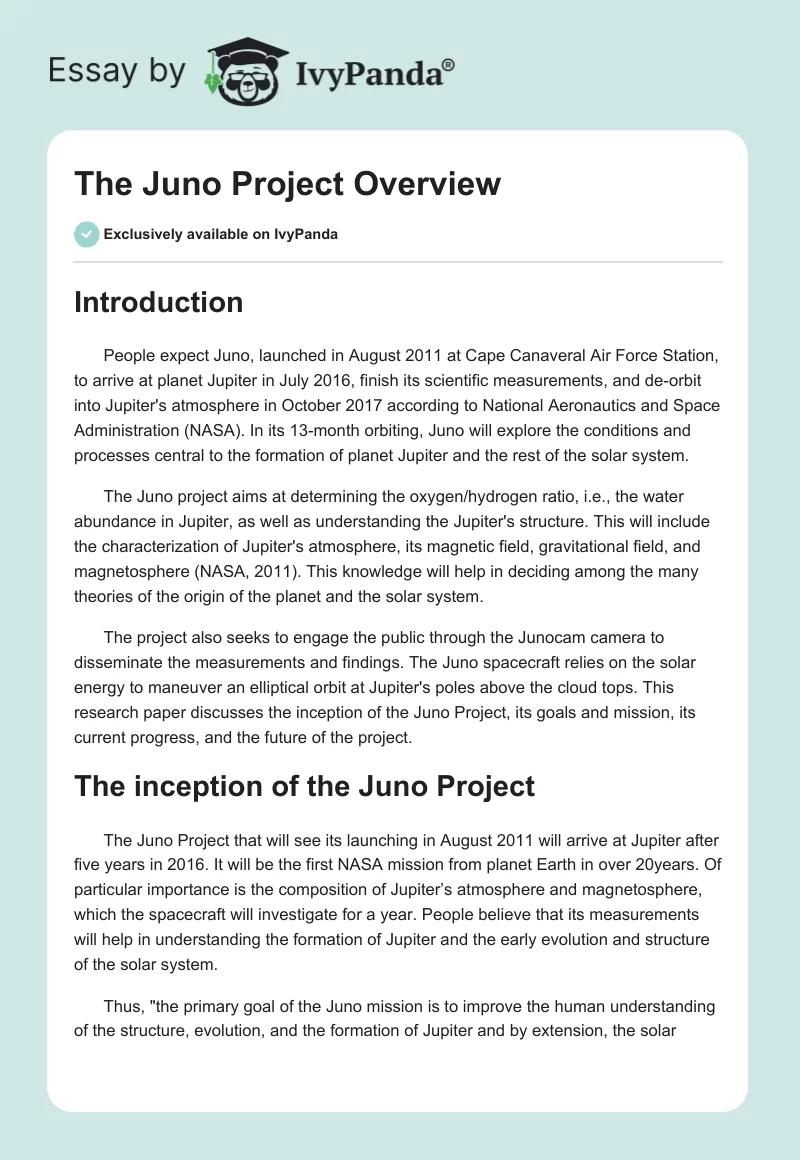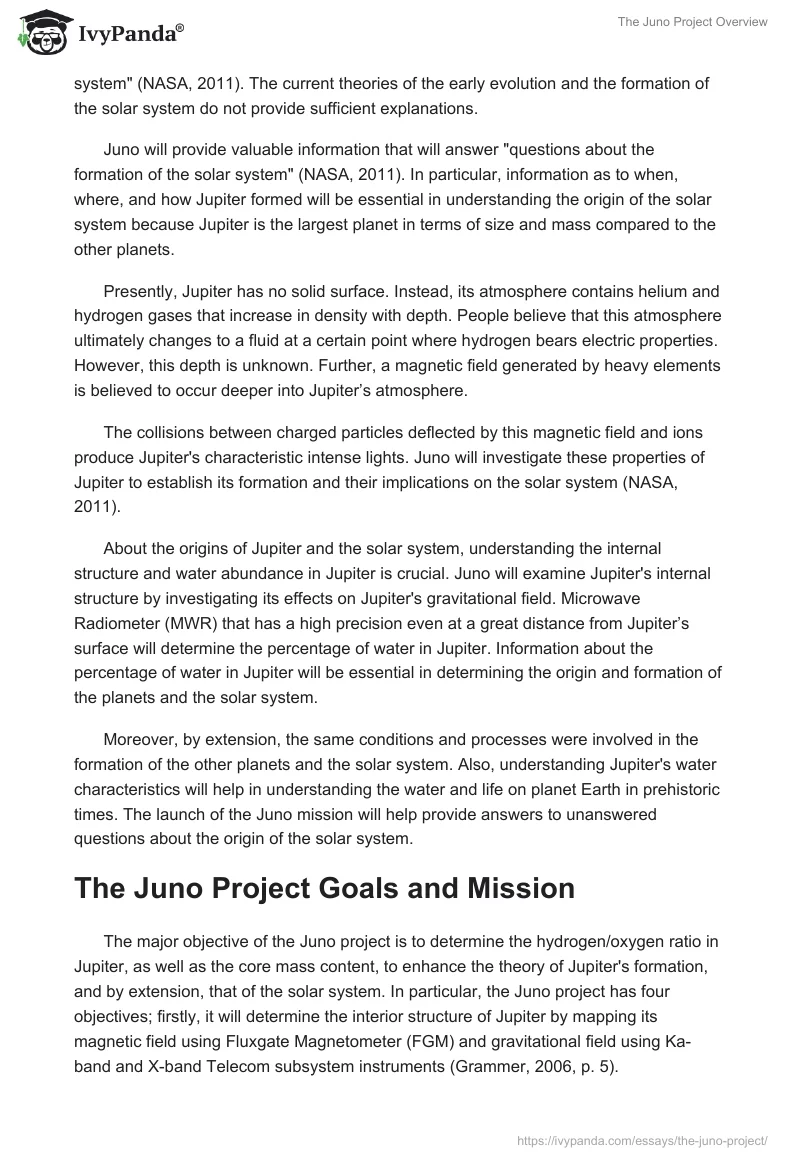Introduction
People expect Juno, launched in August 2011 at Cape Canaveral Air Force Station, to arrive at planet Jupiter in July 2016, finish its scientific measurements, and de-orbit into Jupiter’s atmosphere in October 2017 according to National Aeronautics and Space Administration (NASA). In its 13-month orbiting, Juno will explore the conditions and processes central to the formation of planet Jupiter and the rest of the solar system.
The Juno project aims at determining the oxygen/hydrogen ratio, i.e., the water abundance in Jupiter, as well as understanding the Jupiter’s structure. This will include the characterization of Jupiter’s atmosphere, its magnetic field, gravitational field, and magnetosphere (NASA, 2011). This knowledge will help in deciding among the many theories of the origin of the planet and the solar system.
The project also seeks to engage the public through the Junocam camera to disseminate the measurements and findings. The Juno spacecraft relies on the solar energy to maneuver an elliptical orbit at Jupiter’s poles above the cloud tops. This research paper discusses the inception of the Juno Project, its goals and mission, its current progress, and the future of the project.
The inception of the Juno Project
The Juno Project that will see its launching in August 2011 will arrive at Jupiter after five years in 2016. It will be the first NASA mission from planet Earth in over 20years. Of particular importance is the composition of Jupiter’s atmosphere and magnetosphere, which the spacecraft will investigate for a year. People believe that its measurements will help in understanding the formation of Jupiter and the early evolution and structure of the solar system.
Thus, “the primary goal of the Juno mission is to improve the human understanding of the structure, evolution, and the formation of Jupiter and by extension, the solar system” (NASA, 2011). The current theories of the early evolution and the formation of the solar system do not provide sufficient explanations.
Juno will provide valuable information that will answer “questions about the formation of the solar system” (NASA, 2011). In particular, information as to when, where, and how Jupiter formed will be essential in understanding the origin of the solar system because Jupiter is the largest planet in terms of size and mass compared to the other planets.
Presently, Jupiter has no solid surface. Instead, its atmosphere contains helium and hydrogen gases that increase in density with depth. People believe that this atmosphere ultimately changes to a fluid at a certain point where hydrogen bears electric properties. However, this depth is unknown. Further, a magnetic field generated by heavy elements is believed to occur deeper into Jupiter’s atmosphere.
The collisions between charged particles deflected by this magnetic field and ions produce Jupiter’s characteristic intense lights. Juno will investigate these properties of Jupiter to establish its formation and their implications on the solar system (NASA, 2011).
About the origins of Jupiter and the solar system, understanding the internal structure and water abundance in Jupiter is crucial. Juno will examine Jupiter’s internal structure by investigating its effects on Jupiter’s gravitational field. Microwave Radiometer (MWR) that has a high precision even at a great distance from Jupiter’s surface will determine the percentage of water in Jupiter. Information about the percentage of water in Jupiter will be essential in determining the origin and formation of the planets and the solar system.
Moreover, by extension, the same conditions and processes were involved in the formation of the other planets and the solar system. Also, understanding Jupiter’s water characteristics will help in understanding the water and life on planet Earth in prehistoric times. The launch of the Juno mission will help provide answers to unanswered questions about the origin of the solar system.
The Juno Project Goals and Mission
The major objective of the Juno project is to determine the hydrogen/oxygen ratio in Jupiter, as well as the core mass content, to enhance the theory of Jupiter’s formation, and by extension, that of the solar system. In particular, the Juno project has four objectives; firstly, it will determine the interior structure of Jupiter by mapping its magnetic field using Fluxgate Magnetometer (FGM) and gravitational field using Ka-band and X-band Telecom subsystem instruments (Grammer, 2006, p. 5).
Secondly, the Juno will map Jupiter’s atmosphere to characterize the atmospheric composition, including cloud cover to a depth of over 100 bars. This will involve the use of Infrared Spectrometer and Microwave Radiometer (MWR) instruments. The third objective of the Juno mission will be to map Jupiter’s characteristic “lights.”
This will involve a variety of science instruments such as the Infrared spectrometer (JIRAM), Ultraviolet spectrometer (UVS) and the Jupiter Energetic-particle Detector (JEDI) to characterize the polar magnetosphere (Grammer, 2006, p. 9). Fourthly, the project will educate the public about the origin of the solar system and planets. This will involve the use of a visible camera or a Junocam to transmit images from Jupiter during orbiting.
Current Progress in the Juno Project
High radiation environments and extremely low temperatures are characteristic of the planet Jupiter and thus a challenge to Juno project. However, Aerospace is providing the appropriate support to the management team of the Juno project: systems engineering designs, material expertise, and ways of mitigating operational challenges to ensure a successful mission (McAlpine, 2009, p. 11). About the radiation environments, various approaches have been adopted to mitigate the radiation effects.
The sources of radiation that the Juno flight system must be protected from include the Jupiter particles (Protons, ions, and electrons), the Sun and outer space particles (mainly protons and ions). The electrons and high-energy protons lead to a significantly higher displacement damage dose (DDD) and total ionizing dose (TID) on materials and electronics. The current radiation control strategy for Juno primarily focuses on hardware certification before integration into the spacecraft.
Thus, the high-radiation environment is a serious challenge for the Juno mission. In fact, in the 13-month mission, Juno will get a TID comparable to that received by an Earth-orbiting satellite in a period of12 years (Matousek, 2005, p. 7). The high radiations, along with the cold temperatures in Jupiter, pose a challenge to the spacecraft vehicle, the science instruments and the external surfaces of the spacecraft. A radiation vault houses the science instruments to protect them from the high external radiation.
This will protect them from the high radiation external environment. However, instruments such as antennas and detectors will be exposed to the external environment. In selecting the materials for Juno, testing for radiation tolerance relies on similar the resistance characteristics of similar spacecraft orbiting other planets. Furthermore, the tests take into account the electromagnetic waves generated by the spacecraft itself in engineering the designs.
In the current design, special heat-dissipating components are located at the vault sidewalls to dissipate the heat and radiations into space. At planet Jupiter, the solar arrays typically used to power spacecraft orbiting Mars or Earth cannot generate enough energy to power the spacecraft. Consequently, previous missions to Jupiter relied on thermal energy produced through plutonium decay as their power source. However, over the past 20 years, solar arrays efficient further from the sun have been developed.
Juno requires large and efficient solar arrays: approximately 45 m2 of the solar array, which can produce 450 watts of energy enough to operate at Jupiter (McAlpine, 2009, p. 3). Juno’s solar arrays are so powerful such that, they can only be switched on after the spacecraft has arrived at Jupiter; otherwise, they will damage its electrical system. Accordingly, most of the Juno mission is planned to take place in sunlight, except for a few maneuvers, to maximize power generation and ensure thermal stability.
The Juno spacecraft comprises of the spacecraft vehicle carrying scientific instruments and solar arrays as three wings projecting from the spacecraft vehicle (NASA, 2011). Its solar cells can operate under unusually cold and low-light intensity conditions. Typically, the efficiency of solar cells is high at lower temperatures and high light intensity.
Thus, the low light intensity at Jupiter presents a considerable challenge to the design of Juno’s solar arrays. The solar arrays developed for Juno can produce sufficient and steady energy to power the spacecraft during the mission at Jupiter.
For Juno, the solar array area expands 25 times faster than for spacecraft orbiting Earth. Thus, managing the power usage during orbiting at Jupiter will ensure the success of the mission.
The Juno Science Instruments and their Capabilities
The Juno flight system consists of the Payload and the spacecraft designed by the Lockheed Martin Space System Company (Matousek, 2005, p. 6). Nine instruments located within the Juno spacecraft bear a design that meets the requirements of the Juno mission. The magnetometer (MAG) instruments consist of a fluxgate magnetometer, magnetic clean star cameras, and a helium magnetometer.
All magnetometer sensors are located on one of the solar array wings within the radiation vault. They measure the external magnetic field by subtracting the magnetic field contributed by the spacecraft. The selection criteria for the MAG include the range of magnetic field measured, precision of MAG camera during measurements and electromagnetic cleanliness.
Another instrument for Juno project is the Microwave Radiometer (MWR), which has six receivers that can measure sounds at six different frequencies. Its components are located within the radiation vault. However, the antennas and receivers remain exposed.
The MWR will serve two purposes: firstly, measurement of the depth of Jupiter’s atmosphere (with high pressure of over 100 bars) to determine the structure of the atmosphere below Jupiter’s cloud layer (McAlpine, 2009, p. 3). Secondly, MVR will measure the water abundance globally in Jupiter, measurements that require high precision. The Juno MVR instruments so developed are radiation tolerant and highly accurate.
The gravity science instruments consist of X-band and Ka-band transmitters both on the ground and on the flight system. The use of Ka- and X-systems ensures that the solar wind does not affect the measurements during transmission. Another instrument is the Jupiter Particle-detector Instrument (JEDI) that will explore the Jupiter polar magnetosphere (NASA, 2011). The JEDI sensors are radiation tolerant and thus occur in the radiation vault.
The Jovian Auroral Distribution Instrument (JADI) measures the low-energy ions and electrons to determine the Jovian aurora and Jupiter’s magnetosphere. The JADE electronics occur in a box within the radiation vault. Experts measure the images of the Jovian aurora by the Ultraviolet Spectrograph (UVS).
The Juno UVS comprises of an electronic box and an optical assembly all located in the radiation vault. The plasma and radio waves measure the magnetic and electric fields of various phenomena in Jupiter’s magnetosphere. The waves have both low- and high-frequency receivers and occur in the radiation vault.
The Junocam, a visible-spectrum camera, will take colored, high-resolution pictures of Jupiter’s atmosphere for public education and outreach programs (Matousek, 2005, p. 3). Another instrument is the Juno Infra-Red Auroral Mapper (JIRAM) that will provide high-resolution images of Jupiter’s atmosphere to help in the investigation of the polar aurora.
Conclusion
The Juno project aims at understanding the evolution and formation of Jupiter and the solar system. It primarily investigates the atmospheric constitution, the interior structure, and Jupiter’s polar magnetosphere. However, the mission faces many challenges, among them is how to mitigate the high-radiation environment, the management of the many instruments and low light intensity at Jupiter.
Accordingly, the instruments developed for Juno exhibit radiation tolerance and high accuracy. In the future, the Juno project through the Payload System Management will seek to establish contacts with instrument providers as well as routine schedules and support for each instrument to ensure the success of the mission.
Reference List
Grammer, R. (2006). The Juno Mission Jupiter. 25th International Symposium on Space Technology & Science, 5-11.
Matousek, S. (2005). The Juno New Frontiers Mission. IAC 2005 Conference, 2-9.
McAlpine, W. (2009). Lessons Learned from the Juno Project. EISM Instrument Workshop, 1-14.
National Aeronautics and Space Administration (NASA). (2011). Missions: Juno. Web.


